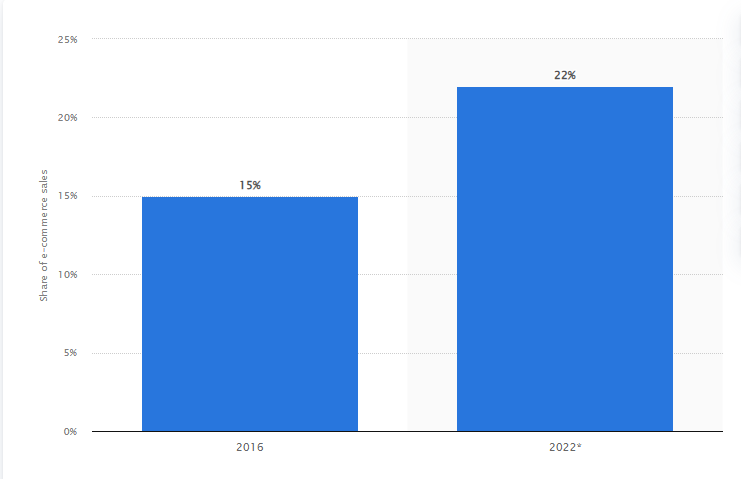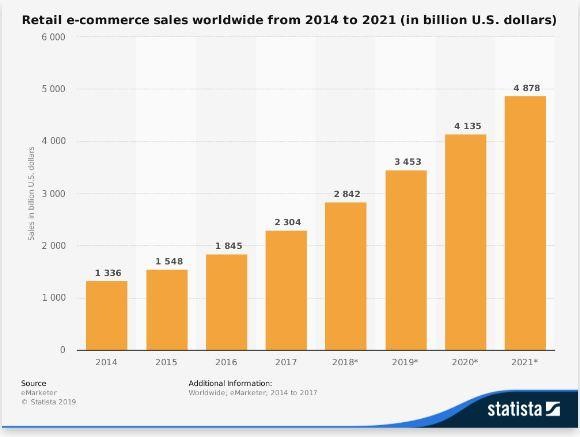Introduction
Today E-Commerce prevalence has enabled consumers to make informed decisions. The approach of online ordering allows shoppers to explore international markets to look for the best deals. On the other hand, it creates immense pressure for the merchants and enterprises to expand their global outreach to be able to deliver their products and services to other countries.
Did you know that cross-border e-commerce has a 22 percent share of the total worldwide online trades?
This share is predicted to grow to $1 trillion in value by 2022. It is interesting to know that the 80 percent share in trades is collectively owned by 12 countries. These include Australia, Hong Kong, the UK, Germany, Singapore, Japan, Brazil, Switzerland, Kuwait, France, and the U.A.E.
This article will take you through the effective strategies to adopt for succeeding in cross-border e-commerce. The current trends will be discussed along with the opportunities making cross-border e-commerce the next big thing.
It is a well-known secret that cross-border purchases have enjoyed a surge in the pandemic as E-commerce became a winner and the need of the day.
Is Cross Border E-Commerce Essential for your Business?
As the geographic borders in e-commerce are blurring out, it has become a necessity for retailers to be globally visible. The pre-pandemic figures for domestic and cross border were like
| Country | Percentage of people shopping internationally |
| U.S.A | 27% |
| Austria | 71% |
| Israel | 16% |
| China | 15% |
But post-pandemic, the ratios have considerably increased as the trend for online shopping surged. It came as a golden opportunity for retailers. In 2019, the cross-border payment flows totaled $130 trillion making payment revenues of $224 billion. In 2020, rapid growth was recorded after the resolution of logistics and delivery issues. A magnificent compound annual growth rate is projected between 2021 till 2026.
These stats suggest the demand for cross-border e-commerce in the retail sector.
Cross-border e-commerce allows brands the opportunity to sell their product to international clients. Sometimes the products that have less recognition or lower demand in domestic markets work well in international markets. So this calculated risk yields benefits when untapped marketplaces are tapped in Asia and other continents.
It is mandatory that cross-border e-commerce should be dealt with as a separate business having its own resource allocation and budgeting requirements. The focus on capturing new markets and enhancing sales makes it essential for businesses to adapt to cross-border e-commerce.
The Need to go Cross Border
To keep up with the customer expectations all businesses need to shift the approach from the domestic market to cross the border.
But the question arises are you ready for international expansion?
As much as it is an accomplishment it also has challenges. There are some signs that help determine the preparedness to go global.
- Hearty National Consumer Base
Once you have outgrown your domestic market, it is advisable to go cross the border for the organic growth of your business. But one thing to keep in mind is to provide a localized experience to international consumers. Your business should cater to the cultural preferences of your global target market.
- Seasonal or Holiday Driven Buying Patterns
If your product falls in the seasonal category like Christmas, January off-season, or back to school, going global will increase the overall demand for your product. It is a great opportunity to even out sales all year round by targeting markets that are not holiday-driven.
- Built-in International Customer Base
You can sense it is the right time to enter an international market when consistent global traffic is coming to your domestic e-commerce site. All brands and retailers need to indulge in market research to get insights into traffic and the countries and regions it is coming from.
- Proven Formula for Competitive Pricing
The landed cost factor adds a lot of complexity when it comes to determining competitive pricing. But retailers having a strong and proven domestic pricing strategy can have an edge over others when entering foreign markets. Having mastered the art of competitive pricing in your home country makes the process feel like an extension, without having to involve in extensive work again.
- Providing Alternative Payment Options
This is the most crucial aspect in expansion as without alternative payment options any business will fail to attract global customers. If customers’ payment preferences are not kept in mind you might not be able to retain existing customers and attract new ones. Domestic retailers who have already adapted to customers’ checkout preferences can confidently enter international markets.
So once the business has realized the importance of going cross border, having all of the above factors in place and already inculcated in the domestic setup will ease the expansion process.
Steps to be a Winner in Cross Border E-Commerce
Let’s look into the foundation of an effective cross-border e-commerce strategy.
Entering new markets is always not as easy as it seems, a number of unexpected challenges await us on the way. A well-defined and tested entry strategy can lead to success. Also, a fool-proof plan is required for the expansion of the logistics including customer service hours, shipping, and returns. To advertise your product globally a solid strategy needs to be developed.
The following objectives help build a strong strategy.
Search and Utilize the Right Channels
The visibility of the products is essential for enabling purchase. Diverse distribution channels are required for the success of cross-border e-commerce. A number of considerations should be kept in mind for choosing the right channels to form a distribution network such as
- Products in demand in foreign countries
- Popular marketing and shopping channels of the targeted countries.
- Existing competition in new markets.
- Time and resources are required to localize the product and translate the product information.
It can be time-consuming to look for lucrative channels as the demand for each channel may vary from country to country. Certain approaches can facilitate testing the demand and enable quick selling such as
- Leveraging online Marketplaces
The best way to target a new market is to utilize channels that already have a global presence. Platforms like Alibaba, Amazon, eBay, and Rakuten are trusted by the majority so your product will reach millions of customers globally. Let us take the example of Amazon which has customers from 180 countries and marketplaces in 11 of them. Having your product listing on Amazon will enhance your global visibility tenfold.
- Tapping on Google Shopping
This Google service hosts a variety of online stores and allows price comparisons to make informed decisions. Instead of relying only on marketplace giants, this platform helps your products get noticed too. It offers additional benefits to advertisers by offering easy currency conversions as well as shipping cost transparency. The transparency results in good product reviews.
- Optimizing Social Media Platforms
It is advisable to utilize the power of social media to promote your product globally. Social media platforms such as Instagram and Facebook blur all geographical boundaries and provide a global presence. It is an ideal way to tap foreign customers and achieve product visibility.
Scan International Competitors
To achieve a strong market approach the businesses need to analyze their competition in foreign markets. To develop an efficient entry strategy we need to analyze the competitor for the following
- Competitive Pricing
The price of your product should be somewhere close to the competitor not too low and not too high to get your share of sales when starting out in the new markets.
- Choice of Channels
As a new entrant, your business should keep an eye on the channels the competitor leverages upon. Target the niche and regional channels utilized by the competitors to grab their prospective customers.
- Keyword Usage
Maybe your competitor is using terminology and product description in a way that attracts more traffic. Always be keen to learn about the valuable keywords that make your competitors’ products more searchable than yours.
Test the Alien Market
The best approach is to first introduce only a few products and check the response rate. Before showcasing your entire product range create only a few listings and learn the market trends from them. Be ready to make adjustments in price or language for product description before creating further listings.
Customize the Product Description
Each touchpoint in the distribution network requires a localized product feed that goes in accordance with the channel. Different countries have their own requirements for product feed and so do different channels and categories. The product descriptions can vary in character length, image specifications, currency, and formatting style.
Putting in all the effort from scratch for each product description on different channels is time-consuming. Instead one can alter the same product feed to serve the purpose on different platforms like Facebook and Google Shopping. The local consumers use different search terms to find the product so it becomes mandatory to localize the language of your product information.
Challenges and Opportunities of Cross Border E-Commerce
As global E-Commerce is growing fast brands and retailers face some challenges when giant tech companies like eBay, Amazon, Facebook, etc keep high commissions and marketing costs. This makes merchants vulnerable when it comes to their own margins. Brands should focus on a direct-to-consumer approach as a long-term growth strategy.
As we have already discussed the challenges in-depth in our previous article, in this article we would look into the opportunities created by the direct-to-consumer approach in cross-border e-commerce.
- Pricing and Brand Control
To mitigate the costs incurred due to reliance on third-party marketplaces brands should add cross-border e-commerce directly to their offering. It will provide a set of advantages such as
- Complete control of customer experience
- Elimination of brand dilution, when seen on the retailers, own website as when presented alongside other sellers.
- Brands will have complete control of the price without having to adjust it according to third-party sellers.
- Brand integrity will be maintained unlike having no control of products displayed adjacent to their listing on other platforms.
- An end-to-end customer experience can be created through merchants’ own websites.
- Reduction in Marketing Costs
Instead of investing in various marketplaces blindly, without having proper insights into the most profitable platform, the direct-to-consumer strategy makes cross-border e-commerce more profitable by
- Lowering Customer Acquisition Cost (CAC) through developing a direct relationship with the customers. Attribution models can be built to understand the winning combination of marketing channels.
- Increasing the overall customer lifetime value (LTV) by strategically retargeting buyers and creating repeat buyer segments through launching brand loyalty programs and programs for customer retention.
- Being able to know your customer(KYC), builds lasting relations and reduces the need for paid marketing.
- Determining Market-Entry
A third-party marketplace may facilitate a brand to expand internationally but it will allow limited access to study the diverse characteristics of each market. These unique characteristics can be
- Logistics and returns
- Payment options,
- Currency display
- Tax and duty implications
Being in direct contact with customers allows brands to determine their market entry and not rely on any third party.
The Bottom Line
This article not only emphasizes the dire need to go cross borders but also discusses how to grab the opportunities for succeeding in cross border e-commerce.
Today is the era of growth without borders, having a strong cross-border e-commerce strategy can take any business to the next level. The retailers need to focus on strategy development and adopt direct-to-consumer cross-border e-commerce. This is a sure-shot formula for success in the international market and will enable the brand to grab a huge market share.
While brands thrive to enter new markets the awareness about competitors and e-commerce platforms is crucial. International expansion requires localizing the product description to stand out from competitors listing.
This step-by-step guide will help your business go global.
CATEGORY
1 on 1 Dedicated Managers
for Personalized Solutions as your very own dedicated in-house team
CUSTOMER CENTRIC
success for our customers at the heart of every action
Transparent & Trusted
clear cut processes trusted by 2000+ global sellers & brands

Amazon Seller Solutions Providers
servicing Amazon’s Global Sellers across Global Marketplaces





